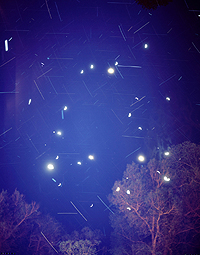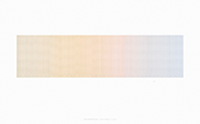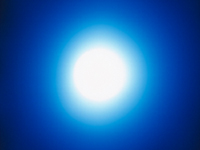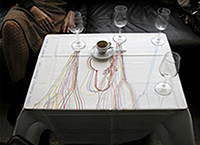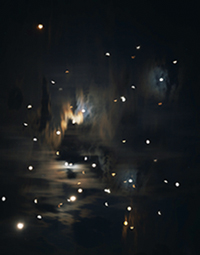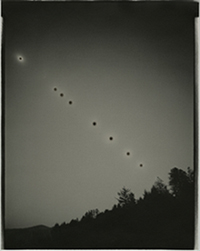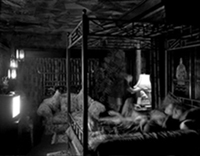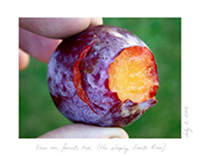| Keeping Time |
||
| November 7, 2008 - January 25, 2009 This group exhibition brings together photographers who deal with concepts of time, duration, and cycles—human, celestial, and photographic—in their work. From its beginnings, photography has been lauded as nature capturing itself and as a method with which to stop, pause, preserve, and contemplate time. Artists include Stuart Allen (TX), Erika Blumenfeld (TX), Rebecca Cummins (WA), Sharon Harper (MA), Chris McCaw (CA), Matthew Pillsbury (NY), Byron Wolfe (CA). Click here to read a review of Keeping Time by the Boston Globe's Pulitzer Prize-winning art critic Mark Feeney In creating their work, each artist in Keeping Time uses a different idea or aesthetic means to capture time and bookend or collect their exposures. For example, several in the show create rules or use outside activities to dictate when the shutter is open and closed. Others follow important celestial markers, like equinoxes, or human markers, like birthdays or conversations. Concomitant with this, a number of the artists incorporate, and often welcome, elements of chance within their work. Time itself is both an experience and a construct. Our understanding and conception of it has changed over time and place. “Standard time” came into being as a result of the railroads needing to coordinate schedules; “daylight savings time” is itself a convention, adopted to take advantage of daylight in the summer months. Today, new developments in physics and astronomy challenge and extend our traditional conceptions of light, space, and time. This work also brings to mind philosophical and mathematical concepts of duration and time—from the theories of Henri Bergson to Albert Einstein. As time seems to pass by faster and faster everyday, these artists grant us a chance to look to the sky and slow down. It is not a far jump, then, for us to contemplate the natural cycle of life and death, not only for astronomical bodies, but for our own bodies as well. Simply put, Keeping Time aims to unite various projects that attempt to make sense of and keep time.
Stuart Allen In his series "Light Maps," Stuart Allen investigates the color of light by exploiting a difference in the manner in which our eyes and cameras perceive light. By disabling the automatic white balance feature of his digital camera, he records the changing color of ambient daylight. Allen places a piece of white sailcloth in front of the lens and creates exposures at predetermined time frames. Cropped and assembled in strips, the images create modified panoramas. Akin to 19th century survey photographs, information at the bottom of each print conveys the time of day, interval captured, and longitude/latitude coordinates. Much like a scientific chart, sunrise and sunset are often pointed out on the spectrum. The resulting artworks could be likened to a 21st century parsing of impressionism. With his work, Allen reminds us that cameras can often tell us something about our environment (and by extension, our perception and conception of it) that we wouldn't otherwise see. Allen's diverse background includes training in architecture and a BFA in photography and video from the Kansas City Art Institute. Allen is collected by national and international institutions and has been an artist-in-residence and commissioned public artist at several institutions in California and Texas. Erika Blumenfeld Using a variety of hand-crafted, “light recording” devices, Erika Blumenfeld documents light at daily and seasonal intervals. Working with natural light and photo sensitive materials throughout her career—from large scale photographs to Polaroid installations—even her video pieces are derived from photographs. In “Moving Light: Spring 2005,” Blumenfeld documented the 93 days between the vernal equinox and the summer solstice. Holding her recording device up towards her source of light, the sun, she took a 2-second exposure every night at 6:17pm (which marked the exact time of civil twilight on the day she began this project). The resulting transparencies were scanned and morphed into a looped video with the timing based on her heartbeat. The pulsating, glowing video gradually grows brighter as the sun moves towards its zenith. Through her work, Blumenfeld hopes to offer us an opportunity to reconsider phenomena that we experience everyday. Originally from the Boston area, Blumenfeld holds a BFA from Parsons School of Design. Now a resident of Marfa, TX, she was drawn to the light in Santa Fe, NM, where she developed this process. Nationally and internationally exhibited, she is a Creative Capital Foundation grant recipient and was awarded a Guggenheim Fellowship in 2008. In addition to rainbow machines, periscope silver goblets, and camera obscura installations, other sculptural and photographic projects by Rebecca Cummins record the movement of shadows. In “Café Gnomonics,” she brings her own tablecloth to a variety of international locations, traces the shadows cast, and documents the outcome. (Gnomonics is the art or science of constructing sundials; the gnomon is the shadow caster or time indicator.) Here, the glasses and bottles act as the gnomons and colored pens are used to record specific times. The result is a physical manifestation of the duration of human acts of conversation or consumption. Cummins taught at Sydney College of the Arts, University of Sydney and is currently an Associate Professor at the University of Washington, Seattle. An artist and cross-disciplinary scholar, her doctoral dissertation, "Necro-Techno: Examples of an Archeology of Media," featured contemporary artists who use vintage media devices. Internationally shown and commissioned, Cummins has recently participated in Biennial of Seville, Spain and the Shanghai Biennial, China.
Using the camera as a transformative agent, Sharon Harper questions conventions of photography. In her series “Moon Studies and Star Scratches,” she accumulates several exposures, made often in several different places, onto one single sheet of film. Her titles read like notes of a conceptual artist or scientist: June 4 – 30, 2005, Clearmont, Wyoming, 15, 30, 20, 8, 5, 1, 5, 2, 1 minute exposures; 15, 8, 10, 14 second exposures. Evoking another aspect of time, Harper often shifts or changes the camera's position to paint the film's surface with light millions of years old. For Harper, this work also draws upon and alludes to the sublime in terms of space, time, and subject. Currently an Assistant Professor at Harvard University, Harper holds an MFA from the School of Visual Arts. Shown internationally, her work is held in the collections of the Whitney Museum of American Art and the Museum of Modern Art. She has held numerous residencies at venues from the Banff Centre in Canada to the UCross Foundation in Wyoming. About five years ago, Chris McCaw fell asleep due to the effects of whiskey during an all-night exposure. The light of the rising sun caused the film to reverse, a process called solarization, and day appeared as night. Today, McCaw uses special military reconnaissance lenses and handmade large cameras to overexpose vintage paper. The resulting one-of-a-kind paper negatives show the effects of the sun literally burning and tracing time. His favorite part of the process is watching smoke come out of the camera and a scent recalling roasted marshmallows emanating from the burning gelatin. McCaw holds a BFA from the Academy of Art in San Francisco, CA. In the last 3 years, he has had close to 30 solo and group exhibitions. The recipient of two grants from the Andy Warhol Foundation, his work has recently been acquired by the Metropolitan Museum of Art and the Victoria and Albert Museum. In his series “Screen Lives,” Matthew Pillsbury captures people experiencing a variety of media via long exposures. Using only available light, Pillsbury leaves the shutter open for the duration of an entire electronically mediated event—a cell phone conversation, movie, video game, or late night television show. The illumination emanating from the various media bathes the rooms with a simultaneous physical presence and psychological absence. A typical title captures the duration and topic of the exposure and hints at an experience gained, or, depending on how you look at it, time lost. Pillsbury attended Yale University for his BFA and earned his MFA in photography from the School of Visual Arts in 2004. Held in over 25 public and private collections, Pillsbury was awarded the 2007 HSBC Photography Foundation Award.
Every day between Byron Wolfe's thirty-fifth and thirty-sixth birthdays, he tried to make one compelling photograph of an ordinary moment. At the end of every day, he reviewed the images, selected one, and wrote a caption. He chose his birthday as a starting point, as it fell in the summer and seemed more appropriate and personal. Inscribed on the prints are phrases and dates that suggest and remind us of the simple things in life and the passage of time. On display in the gallery will be a suite of small framed prints arranged according to the four seasons. Everyday: A Yearlong Photo Diary was published by Chronicle Books in 2007. Wolfe earned his MFA from Arizona State University and is currently an Associate Professor at California State University at Chico. Among his numerous awards and honors, Wolfe was selected for the 2004 Santa Fe Prize for Photography. Wolfe has been frequent and long-time collaborator with Mark Klett. |
|
|
|
|
||
